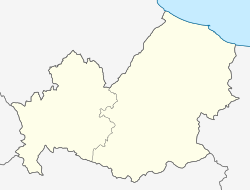Mirabello Sannitico
This article needs additional citations for verification. (February 2021) |
Mirabello Sannitico | |
|---|---|
| Comune di Mirabello Sannitico | |
 | |
 Coat of arms | |
show Location of Mirabello Sannitico | |
 Mirabello Sannitico Location of Mirabello Sannitico in Italy | |
| Coordinates: 41°31′N 14°40′E / 41.517°N 14.667°ECoordinates: 41°31′N 14°40′E / 41.517°N 14.667°E | |
| Country | Italy |
| Region | Molise |
| Province | Campobasso (CB) |
| Government | |
| • Mayor | Angelo Miniello[1] |
| Area | |
| • Total | 21.43 km2 (8.27 sq mi) |
| Elevation | 600 m (2,000 ft) |
| Population (30 November 2017)[3] | |
| • Total | 2,132 |
| • Density | 99/km2 (260/sq mi) |
| Demonym(s) | Mirabellesi |
| Time zone | UTC+1 (CET) |
| • Summer (DST) | UTC+2 (CEST) |
| Postal code | 86010 |
| Dialing code | 0874 |
| Patron saint | St. George |
| Saint day | April 23 |
| Website | Official website |
Mirabello Sannitico is a small town in the province of Campobasso, Molise, southern Italy. The population is about 2,100 inhabitants. It has anagrarian-based culture and history, dating back to at least the 12th century. Nearby towns include Campobasso to the northwest and Vinchiaturo to the southwest. The Tappino River flows on either side of the town on the north and south.
History[]
The oldest reference to the town appears in a church register in February 1193, where the abbot Ferulfo mentions the church of Saint Salvator of Mirabello (whose location and ruins are now lost), adjacent to the Tappino river. Numerous bloody battles were fought over water rights for the land between Mirabello Sannitico and Ferrazzano. Many earthquakes have historically plagued the area. This region suffered large earthquakes in 847, 1294, 1309. Other temblors struck in 1456, 1587, 1688 (no deaths, as the quake occurred when most were in the fields) and 1794. On July 26, 1805 an earthquake struck the area that killed nearly 6,000 people in Molise and 300 in Mirabello and turned a previously damaged church, San Nicola, to rubble.
Main sights[]
The town is laid out in a classic medieval fashion, with a radial array of streets surrounding the principal church, Santa Maria Assunta in Cielo. The earliest known reference to the church is in an ecclesiastical inventory of Bojano diocese of August 20, 1241, executed by the notary, Guglielmo, under Giovanni Capuano of Naples, on order from Emperor Fredrick II of Svevia. Other churches include Holy Maria of the Assumption (Santa Maria di Annuziata), San Rocco, San Giorgio, and in the nearby hills, Santa Maria di Monteverde. Stone town walls and huge arches are readily appreciated. The principal street, so named as in nearly all Italian towns, via Roma, in accord with a 1930s decree by Mussolini changed from via San Nicola leads from the main piazza abutted by the main church and leads out of town. The relics of this history remains with a statuary of Saint Nicholas in the wall at the end of via Roma and vici named San Nicola II and III. At the end of via Roma lies an ancient well, where the cap stones have numerous deeply carved vertical grooves due to centuries of hauling water with buckets and ropes.
Culture[]
The townspeople observe many feast days, celebrating in traditional style with parades, religious processions, and fireworks. The most elaborate celebration is for the feast of Saint George, the patron saint of the town. It is celebrated on 23 April. Others include the feast of Saint Joseph (19 March), Saint Anthony (June 13), Ferragosto (15 August), and Epiphany (early January) as well as Christmas and Easter. Many inhabitants still make their own wine; preserve tomatoes; make olive oil, and slaughter a pig shortly after Christmas (ritualistically imitating centuries of forebears who did the same to provide meat throughout the coming year).
Emigrants from this town are scattered throughout the world. From about 1880 to 1925 many settled in New York City, Philadelphia and Cleveland. After World War II emigration to Canada, Switzerland, and South America was more common.
References[]
- ^ "Comune di Mirabello Sannitico". www.comune.mirabellosannitico.cb.it. Retrieved 22 March 2020.
- ^ "Superficie di Comuni Province e Regioni italiane al 9 ottobre 2011". Istat. Retrieved 16 March 2019.
- ^ "Popolazione Residente al 1° Gennaio 2018". Istat. Retrieved 16 March 2019.
External links[]
- Cities and towns in Molise
- Municipalities of the Province of Campobasso


